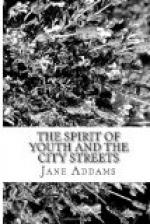It is neither a short nor an easy undertaking to substitute the love of beauty for mere desire, to place the mind above the senses; but is not this the sum of the immemorial obligation which rests upon the adults of each generation if they would nurture and restrain the youth, and has not the whole history of civilization been but one long effort to substitute psychic impulsion for the driving force of blind appetite?
Society has recognized the “imitative play” impulse of children and provides them with tiny bricks with which to “build a house,” and dolls upon which they may lavish their tenderness. We exalt the love of the mother and the stability of the home, but in regard to those difficult years between childhood and maturity we beg the question and unless we repress, we do nothing. We are so timid and inconsistent that although we declare the home to be the foundation of society, we do nothing to direct the force upon which the continuity of the home depends. And yet to one who has lived for years in a crowded quarter where men, women and children constantly jostle each other and press upon every inch of space in shop, tenement and street, nothing is more impressive than the strength, the continuity, the varied and powerful manifestations, of family affection. It goes without saying that every tenement house contains women who for years spend their hurried days in preparing food and clothing and pass their sleepless nights in tending and nursing their exigent children, with never one thought for their own comfort or pleasure or development save as these may be connected with the future of their families. We all know as a matter of course that every shop is crowded with workingmen who year after year spend all of their wages upon the nurture and education of their children, reserving for themselves but the shabbiest clothing and a crowded place at the family table.
“Bad weather for you to be out in,” you remark on a February evening, as you meet rheumatic Mr. S. hobbling home through the freezing sleet without an overcoat. “Yes, it is bad,” he assents: “but I’ve walked to work all this last year. We’ve sent the oldest boy back to high school, you know,” and he moves on with no thought that he is doing other than fulfilling the ordinary lot of the ordinary man.




